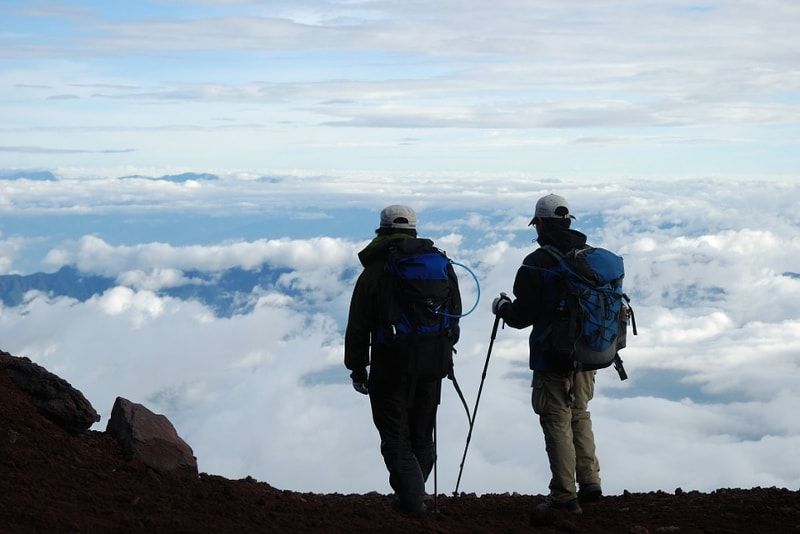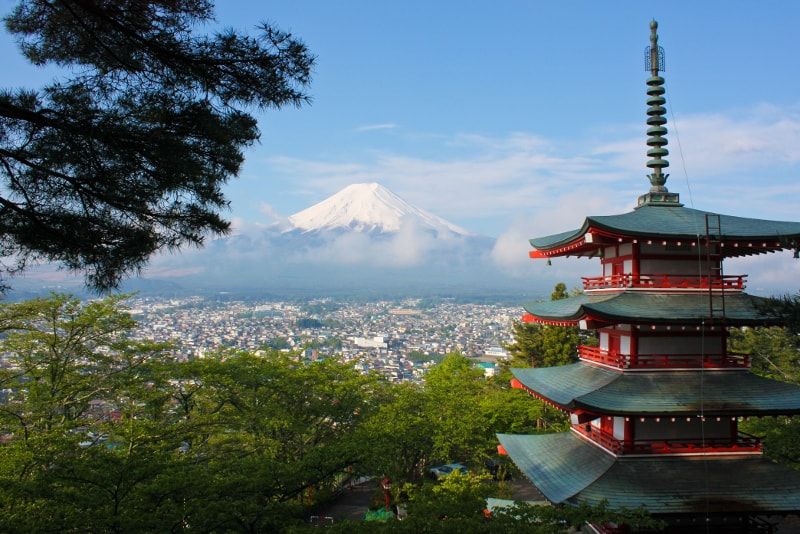Mt. Fuji: Day Trips and Tours from Tokyo
A day trip to Mont Fuji from Tokyo is your chance to see Japan’s highest and most majestic mountain. Listed as a UNESCO World Heritage site in 2013, Mont Fuji is the most iconic image of Japan and a must-visit attraction for Tokyo first-time visitors.
A day trip to Mont Fuji from Tokyo is your chance to see Japan’s highest and most majestic mountain. Listed as a UNESCO World Heritage site in 2013, Mont Fuji is the most iconic image of Japan and a must-visit attraction for Tokyo first-time visitors.

(0/24) checking Musement...
A day trip to Mont Fuji from Tokyo is your chance to see Japan’s highest and most majestic mountain. Listed as a UNESCO World Heritage site in 2013, Mont Fuji is the most iconic image of Japan and a must-visit attraction for Tokyo first-time visitors.

Continue reading our guide to learn more about Mount Fuji, one of the most breathtaking day trips from Tokyo.
Traveling to Mt. Fuji from Tokyo
Mount Fuji is located about 150 kilometers southwest of Tokyo. You can travel there with different modes of transportation.
By car
The drive presents a ton of scenery and takes about 2 hours, but that heavily depends on the traffic leaving Tokyo.
By bus
Tour buses depart from Tokyo for Mount Fuji every day. It’s a simpler and more relaxing way to visit Mt. Fuji compared to driving a rental car.
By train
Japan is sophisticated in many ways, including its rapid public transportation. Taking a bullet train is an exciting way to reach Mt. Fuji.
Guided tours
If you want to avoid the hassle of organizing your trip, join a guided tour to Mount Fuji from Tokyo. Several tours are available that suit your choice of transport, including trains, buses and cruises.
Best Mt. Fuji tours
Bus tours
A Mt. Fuji day trip from Tokyo is very enjoyable via a tour bus. It gives you ample time to gaze out the window of the bus and appreciate the sights as the terrain shifts from a metropolis to Fuji-Hakone-Izu National Park.
Lake cruises
Another popular type of tour around Mt. Fuji is a lake cruise. Two of the most popular lakes to cruise on are Lake Ashi and Lake Kawaguchi. It’s a relaxing way to spend time with family or friends among the rich nature and culture of Japan.

Bullet train tours
Bullet trains are an exciting way to reach Mount Fuji from Tokyo. Not every country features a bullet train, so it’s a new and unique way to get from point A to point B. The tour often includes stops at other locations along the way.
Private tours
For the most exclusivity and convenience, you can book a private tour to Mt. Fuji with your own personal guide and driver to show your group the best of Mt. Fuji and the surrounding area.
Mt. Fuji tour prices
The cheapest option starts at only US$82 per person.
A day trip to Mt. Fuji with a lake cruise costs from US$126 per person for a return by bus to US$149 per person for a return by bullet train.
The price of Mount Fuji day trips that include a bullet train ride starts at about US$149 per person.
Our most popular private tour to Mt. Fuji and Hakone is US$650 for a group of up to 5 people.
What to see and do
Taking a Mt. Fuji day trip from Tokyo is a special experience where you see the drastic contrast of all Japan has to offer to tourists. Along with having one of the most sophisticated and productive metropolitan places in the world, Mt. Fuji is a unique opportunity to get connected with the origins and spiritual side of the country.
Sightseeing
The drive from Tokyo to Mt. Fuji is memorable. You’ll cherish the sights as you transition from a massive metropolitan area to a rural portion of Japan that gets you more in-tune with nature.
The diversity of the trip is hard to match elsewhere. However, it is a great idea not to attempt to make the drive on your own, especially if you are unfamiliar with Japan. Booking a day trip from Tokyo is a more laid back and relaxing way to see the sights.
Hiking

Mount Fuji is a popular place for hiking to summit. Over one hundred thousand people make the trek every year, primarily between July and August when the weather is the most ideal. Summiting the peak is discouraged from mid-fall to late spring.
Hikers savor the opportunity to experience goraiko, or “arrival of light” by climbing the peak at night and reaching the summit near sunrise. Four routes take you to the summit. Even if you don’t wish to visit the summit, there are several other trails in the area to see the volcano from its base and snap some incredible photos.
Paragliding
Another thrilling adventure at Mt. Fuji is paragliding. Most outfitter experiences take off at the fifth station climbing route called Gotemba. However, there are other departing locations for paragliding based on the wind direction and weather.
Paragliding isn’t for everyone, but what better place to experience such a thrill from the air? You’ll have the time of your life and go back home with something to rave to your friends and family about throughout your trip.
Lake cruises
Lake Ashi, or Hakone Lake, is along the southwest wall of Mount Hakone. Mount Hakone and Mount Fuji share similarities in being volcanos that stand far above the rest of Japan. The lake is known for its incredible views of Mt. Fuji.
You can also take lake cruises for a relaxing way to kick back on the water and appreciate the sights. Many of the boats assume the presentation of sailing warships which adds to the value of the experience. Hiking and camping are also available in the area.
If you have more time, don’t hesitate to make a stop at Kawaguchiko Lake. The scenic lake is the second largest of the Fuji Five Lakes. It does get cooler than other lakes in the area because of its elevation.
Kawaguchiko Lake borders Fuji-Hakone-Izu National Park where many other recreational opportunities exist. The resort area supports activities in the area like dining, shopping, windsurfing, boating, hiking, and camping.
Places to visit on the way to Mt. Fuji
A Mt. Fuji day trip from Tokyo takes a couple of hours in travel time in each direction, depending on the type of tour. Along the way, you’ll have several opportunities to make detours and see other attractions in the region.
There are a few different ways to reach Mount Fuji from Tokyo. The method of transportation and direction of travel depends on if you are stopping at any other sights along the way.
Lake Kawaguchi
Lake Kawaguchi is a popular detour if you are traveling north of Mount Fuji from Tokyo. The lake features the longest shoreline of any of the Fuji Five Lakes. It is also the most established in terms of tourism, given its proximity to Fuji-Hakone-Izu National Park. The resort area offers lodging, food, shopping, and outdoor activities. The views of Mt. Fuji are excellent.
Lake Ashi
Lake Ashi exists south of Mount Fuji in contrast to Lake Kawaguchi. The lake is sometimes referred to as Hakone Lake because of its proximity to the rural community. The crater lake is known for its lake cruises and outstanding views of Mount Fuji.
The lake also offers different hot springs and historical sites. It exists along the Tokaido road, which serves as the main connection between Tokyo and Kyoto. Therefore, many travelers on an Mt. Fuji day trip from Tokyo frequents the area.
Hakone
Hakone is a small community that is a sharp contrast from the booming metropolis of Tokyo. It’s a popular tourist stop with nearly as many visitors each day as locals, especially during the peak travel season.
It also provides specular views of Mount Fuji. The area has a close connection with Lake Ashi and its hot springs, designating it as a must-visit. You can also learn a lot about its history by visiting a museum or local event.

Fuji-Hakone-Izu National Park
Fuji-Hakone-Izu National Park includes Mount Fuji, Hakone, Fuji Five Lakes, and the Izu Islands. It is immensely popular among tourists considering its reasonable drive from Tokyo. The natural wonders of the region are extremely influential in local traditions.
Fuji-Hakone-Izu National Park contains several interesting attractions. The terrain ranges from mountainous areas to lakes and coastlines. There are more than 1,000 volcanic islands in the region, as well as several hot springs.
Best time to see Mt. Fuji
The best period to admire Mount Fuji would be from October to February, with December and January being the best in terms of visibility.
The worst times to attempt to view Mount Fuji would be during the summer season, between the months of June and August. Rainy months of June and July, as well as typhoon peak seasons in late August and September, often offer a poor visibility.
If you plan on climbing Mount Fuji, you only have a window of a couple of months in the summer.
Travel tips
- Plan your trip in advance. Mount Fuji is a very popular place to visit in the summer months from Tokyo. Tours sell out fast.
- Prepare for Mother Nature. You never know what the weather is going to throw at you, even during the summer months, so make sure you are ready with appropriate clothing.
- Bring plenty of water and snacks. Outdoor adventures require you to stay hydrated and well-balanced with some food in your system. Don’t forget to pack the snacks!
